#some their designs may be outdated at this point
Explore tagged Tumblr posts
Text
My OCs :3
Main-
Heroes of Ferelden: Rhiannon Tabris (romancing Alistair) and Aelon Mahariel (romancing Morrigan). Dual Warden Worldstate
Champion of Kirkwall: Anwen Hawke (romancing Fenris)
Inquisitor: James Trevelyan (romancing Cassandra)
Rook: Lydia Laidir (romancing Lucanis)
Secondary OCs-
Arlessa of Amaranthine: Katherine Cousland (romancing Ser Gilmore)
Arcane Advisor to the Inquisition: Aveline "Ava" Trevelyan
Her Pupils: Lucas Amell and Madolyn Surana
Shadow Dragon Agent: Calypso Mercar
If I yap about them or draw art of them, they'll be tagged as "oc: [their name]"! (so "oc: anwen hawke" or "oc: ava trevelyan")
0 notes
Text
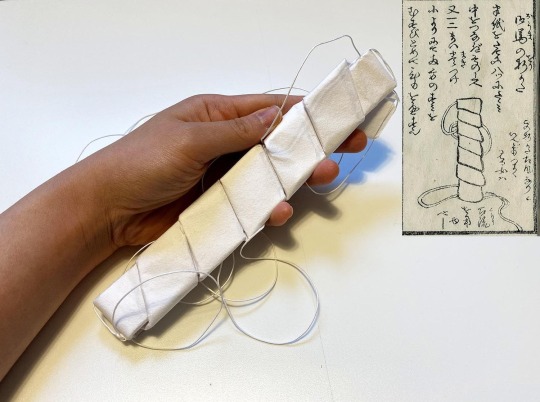


Cw: We are going to talk here about periods, and sex education in the past. Read this note according to your own sensibilities :)
How women dealt with periods during Edo period, article by shunga enthousiast Shungirl who made a paper pad following instructions found in makura bunko 枕文庫 - ie ancient sex books illustrated with erotic ukiyoe.
One of such makura bunko is 渓斎英泉 Keisai Eisen's 閨中紀聞-枕文庫, first published in 1822. It details Chinese remedies recipes for menstrual pains and irregularities, give tips about sex, and information about menstruations and pregnancy. From a modern point of view, some beliefs are outdated, but it was then such a bestseller it went through several reeditions.
Several words were apparently in use during Edo era to designates menstrual period: keisui 経水, gekkei 月経, tsukiyaku 月水, etc.
When girls went throught their first period, their females relatives or nannies would taught them how to deal with them. One method was to use paper as sanitary products (please note people without easy access to paper probably dealt with periods differently).
__________ 御馬 paper pads
Sanitary pads, such as the one recreated above by Shungirl, were then called mima 御馬 (probably as a pun on true "mima" which were then fine horses own by noblemen, or attached to sanctuaries as mounts for gods etc) or simply ouma お馬 ("honorable" horse).
Ouma were made from inexpensive recycled paper called Asakusagami 浅草紙. Sheets were folded 8 times, tied with twisted paper strings (koyori 紙縒), and then wrapped with another layer of folded paper. It was secured once again with paper strings.
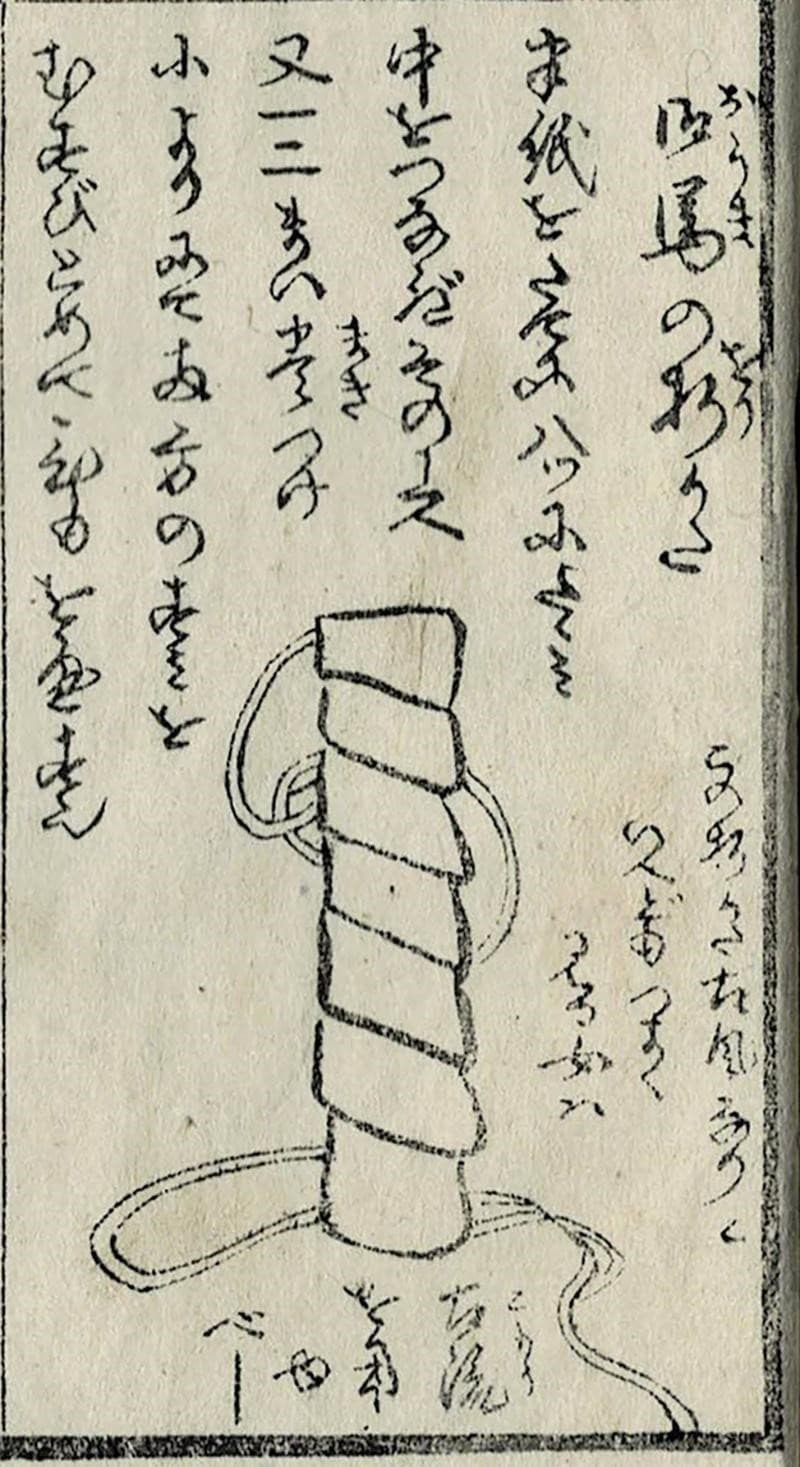
Part of the strings could be left long so to tie around the waist, or/and pad was hold into place by wearing fundoshi 褌 loincloth (which would also help prevent leaking on inner tights).
Asakusagami quality was low (it was also used as toilet paper) so paper pads had to be changed often, meaning you had to fold quite a lot of them to go through your period!
Shungirl folded the pad above following instructions found in the book 実娯教絵抄, which provided several other "models":
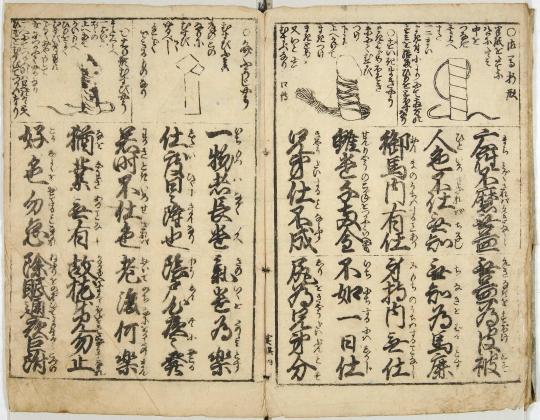
__________ 詰め紙 paper tampons
Another method for dealing with periods were tampon-like paper bundles which were inserted into the vagina, the 詰め紙 (tsumeshi? I am not sure of the reading).
This method may have first appeared in red-light districts (?). Beside its use for periods, prostitutes also used those tampons as method of contraception (OP has an interesting article on this subject).
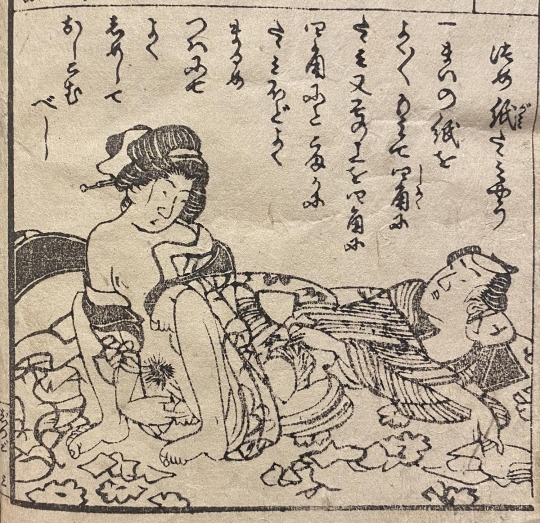
By the end of Edo period and into Meiji, paper tampons were widely used even by women who were not prostitutes - despite voices branding this method as unsanitary.
__________ About girls' coming of age rites
Menarche (first period) was an important milestone for girls, and was celebrated as such via specific rites (shochō o iwau 初潮を祝). Those differed a lot from places to places, and also depended on social status.
Celebrations would concern close family, but often spread to wider community who could received for example a festive meal (sekihan 赤飯) for the occasion (some Edo era senryû poems stress how mortifying this publicity could be!).
Interestingly, some traditions were also pretty sweet: in some places, mothers would sew 3 stiches into their daughter's underskirt (koshimaki 腰巻き) as a good luck charm, hoping their periods would last only 3 days <3
Those rites were part of coming of age traditions (seijoshiki 成女式) which marked the start of a young woman adulthood. Another example is the blackening of teeth (ohaguro お歯黒) which usually started around 16-17 years old.
Celebrating menarche publicly was a way of advertising that the girl was no longer a child and would "soon" be a bride. Yet, if menarche often took place around 13-14 years old, in reality it was somehow unusual to have girls married so soon!
Before marriage, especially in non-noble/samurai families, young women often started their sexual life via flings or yobai 夜這い ("night crawling" ie pseudo-secret nighttime encounters) before any wedding actually took place.
#cw: periods#cw: sex mention#japan#japanese history#edo period#edo era#periods#sex education#sex history#sanitary pads#tampons#paper pads#ouma#mima#paper tampons#tsumeshi#coming of age rites#ressources#references
628 notes
·
View notes
Text
Origins of legendary Pokemon: gen IV
It's been a long time since I wrote one of these posts, but I'm back now to examine the real-life inspirations of legendary and mythical Pokemon. for previous generations see gen I, gen II, and gen III. For previous series I did like this see all fish Pokemon, all non-fish aquatics, and all starters.
The lake trio kind of fit as the Mew clones of gen IV, at least in them being small, floating psychic-types that look a lot like Mew. The three are based on and named after fairies from European legend: Uxie the pixie, Mespirit the sprite, and Azelf the elf or Agnome the gnome. The three may also be based on the three highest ranks of angels from the traditional Christian hierarchy invented by the writer Pseudo-Dionysus. Like angels, the lake trio were created by and presumably work for Arceus, the Pokemon god. Uxie most likely lines up with the Cherubim, angels that are associated with knowledge and wisdom. Mesprite could be associated with Seraphim, who are associated with love. Azelf would be associated with Thrones/Ophanim, who are sometimes called 'valiant ones'. In addition, the lake trio draw from the three sacred treasures or imperial regalia of Japan, three artifacts ascribed with mythical origins that are each associated with a a particular virtue. They are the sword Kusanagi no Tsurugi (associated with valor and with Azelf, who brings willpower and lives in Lake Valor), the mirror Yata no Kagami (associated with wisdom and Uxie, who created knowledge and lives in Lake Aquity) and the bead Yasakani no Magatama (associated with benevolence and Mesprit, who created emotion and will punish those who disrespect it). Uxie, Mesprit, and Azelf's names also abbreviate to UMA, which in Japanese means 'unidentified mysterious animal', another term for cryptid, animals that are believed to exist by some people but are not recognized by science. The lake trio being mythical beings who live in lakes fits with famous cryptids like the Loch Ness monster.

(image: an artists impression of the three sacred treasures. The actual treasures are kept from the public by the Japanese royal family and some historians doubt whether they actually exist. The mirror is a bronze disc decorated with intricate designs and covered in rust. The sword is a double-edged straight sword with intricate points on the blade, which is chipped and rusty. The bead is a curved magatama bead made from jade with a hole bored in it. End ID. Source).
The creation trio or Pokemon of myth may also be based on angels as they serve the Pokemon god lust like the lake trio. In that case, Giratina would be a fallen angel or even Satan as it was banished to the distortion world by Arceus for it's dangerous behavior like how fallen angels rebelled with Satan and were banished to hell. Dialga and Palkia are physically based on dinosaurs, Dialga being one of the quadrupedal, long-necked sauropods and Palkia being one of the bipedal theropods, though it's upright, tail-dragging pose comes from outdated and inaccurate theropod reconstructions. The Japanese word for dinosaur, kyoryu, contains 'ryu', which means 'dragon", so there is a heavy association of dragons and dinosaurs in Japanese media.


(Image id: left: art of a theropod dinosaur. It is a bird-like reptilethat stands on two legs and has small arms. Its body is covered in feathers and it has a long tail. right: art of a group of sauropods. They are very large quadrupedal reptiles with long necks and tails. End Id. Source 1, Source 2)
The origin forms for Dialga and Palkia make them look more like Arceus and therefore make them based on the qilin or longma. I will go over those origins when I discuss Arceus. Palkia's origin form also looks like an armless centaur. Giratina looks more like a centipede or insect in its altered form and a serpent or serpentine dragon in its origin form. Since Dialga and Palkia are dragons, Giratina may be based on an omukade, a gigantic centipede in Japanese folklore that devoured dragons. Centipedes are often associated with impurity in Shinto, which goes with Giratina being a fallen member of the creation trio. The typings of the trio could come from states of matter. The steel-type Dialga is based on solids, the water-type Palkia is based on liquids, and the ghost-type Giratina represents gasses. The story of Dialga and Palkia likely comes from the Shinto creation myth. In said myth, the gods Izanagi and Izanami used a spear to create one island, placed a pillar on that island, and created the rest of the islands from it. Dialga and Palkia are credited with creating Sinnoh from Spear Pillar.
Like the other Regis, Regigigas is based on a golem. Golems are being of semitic legend that are made of inanimate matter and animated via magic. The most famous golem legend is the golem of Prague, which was made of clay and was animated with a word either etched on its forehead or on a tablet that was placed in its mouth. The dots on Regigigas's head represent the writing on the golem's forehead. Regigigas being involved with the creation of the world before being sealed in Snowpoint Temple could come from the Greek legend of the titans, the generation of gods before the Olympians who were defeated and sealed away in a war. Specifically, Regigigas draws from the titan Prometheus, who created humanity at Zeus's request and ended up siding with humans against the other gods. For stealing fire from the gods to give to humans, Zeus imprisoned Prometheus. In LA, the flame plate description mentions a punishment for defeated giants, which likely references the fate of the titans. Slow Start may be part of Regigigas's punishment for whatever it did. Regigigas also draws from the Daidarabotchi, a Japanese giant so big it could be mistaken for a mountain while sleeping. In one legend, a demigod named Omizunu was said to be as big as a Daidarabotchi. He wanted to expand his domain, so he chopped off pieces of a nearby island and used ropes to drag them over to his domain. This is the origin of Regigigas dragging the continents into their current configuration with ropes.

(Image: traditional Japanese art depicting Omizunu visiting a hot spring and meeting another character. He is depicted as a giant wearing robes and beads ans is much larger than the other character. Original artist unknown. End ID)
Heatran seems to be based on myths from around the word that explain volcanoes by claiming a monster or deity lived in them. Many cultures would attempt to appease this monster through rituals to keep the volcano from erupting. Heatrean's fire-steel typing comes from the intense heat within the planet and it's iron core. Not a lot more here.
Darkrai and Cresselia are based on phases of the moon and dreams. Cresselia's name and design identifies it as being based on the crescent moon while Darkrai is based on the new moon, when the night is darkest. Cresselia has a lot going on for a minor legendary. It looks like a swan to reference the constellation Cygnus ad the rings around it look like planetary rings as wells as auroras and hagoromo, garments worn by the Tennin, divine beings in Japanese Buddhism who have the power to bring good luck like how Cresselia can bring good dreams. The hagoromo grant the Tennin the power of flight, something Cresselia is shown to have. One play called Hagoromo depicts a man stealing a female Tennin's robe to prevent her from returning to the heavens and force her to marry him. Scholars have pointed out a similarity between this play and western swan legend stories. Cresselia's color scheme comes from the robes of the Chinese moon goddess Chang'e. LA adds mention that Cresselia resembles a heavenly maiden who created the milky way. This could reference the Estonian goddess Lindu or Greed titaness Rhea, both of which are credited with creating the milky way and are associated with birds. Finnish mythology also stated that the milky way was a patch that birds would follow to reach Linutoko, the home of birds.

(Image: art of a Tennyo (female Tennin) by Matthew Meyer. She looks like a human woman flying in the sky wearing a long skirt and flowing pink hagoromo robes that flow around her body. She also wears jewelry and white makeup and carries a pair of cymbals. End ID).
Darkrai being a bringer of nightmares draws from mythical creatures from cultures around the world that would bring nightmares and often sit on people's chests while they did so. Examples of these creatures include the German Alp, Thai Phi Am, Turkic Basty, Philippine Batibat or Bangungot, Catalan Pesanta, and Germanic and Slavic Mara or Mara or Zmara. The prevalence of these beings in so many separate cultures is believed to be the result of sleep paralysis. This is a medical condition where the body partially wakes up, leaving them conscious but paralyzed. Hallucinations are common during sleep paralysis and common hallucinations include an intruder or monster sitting on or standing above the person being paralyzed. A specific nightmare monster Darkrai may draw from is the Slavic Notsnitsa, which could be warded off by placing a knife or adder stone under the pillow. This is likely the origin for Cresselia's lunar wing protecting against Darkrai's nightmares. Sleep paralysis may also be part of the inspiration for boogeymen or other monsters that lurk in children's bedrooms, which are likely another inspiration for Darkrai. For more modern folklore, Darkrai may draw from stories of shadow people, ghost-like beings of shadow that are also likely partially inspired by sleep paralysis. Physically, Darkrai being a humanoid to becomes an indistinct cloud at the waist draws from popular depiction of genies.

(Image: The Nightmare, a painting by Henry Fuseli, 1781. It depicts a sleeping woman in a white nightgown hanging off of a bed. A goblin or imp-like creature is sitting on her chest and a black horse looks in from behind a curtain. This represents folklore that says mares would steal and ride people's horses and sit on people's chests to cause nightmares. End ID)
Shaymin has one of the most simple and yet genius design inspirations for any Pokemon. It's a literal hedgehog. It likely also draw from chis pets, sculptures which plants grow from. It being the gratitude Pokemon and having flowers and buds growing on it makes it a living bouquet. Sky form Shaymon looking somewhat like an ungulate may reference Santa's reindeer. The red petals on its neck could draw from an aviator's scarf or the scarves worn by many heroes in sentai stories. Shaymon purifying the air references environmentalism and cleaning up pollution, as well as plants use in filtering harmful chemicals from water, soil and air.

(Image: a hedgehog standing in grass. It is a small, brown, round mammal with a pointy snout, and short spines covering its back. End ID)
The lake trio may be Mew clones in looks and typing, but Manaphy takes the role in stats and being a mythical. Manaphy and Phione are weird Pokemon. Manaphy can only breed with Ditto, and can produce only Phione as an offspring. Phione can also breed with Ditto and only makes more Phione. Manaphy only producing Phhione could be a reference to eusocial animals. These animals live in colonies which usually only have one breeding female, a queen, who produces non-breeding drones to act as workers and guards. Manaphy could be the queen bee with Phione as the drones. Manaphy's role as a sea guardian could come from sea deities line Greek Nereids. In that case, Phione could be a demigod a half-god who is still more powerful than a mortal but less than a full deity. Physically, Manaphy and Phione are based on sea slugs of the genus Clione, commonly known as sea angels. These are free-swimming, translucent sea slugs that are popular in Japan, especiall in Hokkaido, the island Sinnoh is based on.

(Image: Clione limacina, a sea angel. It is a long, slender sea slug with a distinct head and two wing-like fins. Most of its body is translucent, except for its digestive organs, which are bright orange. End ID)
We have reached the original one itself, Arceus. Arceus is based on creator deities, gods from cultures worldwide who are responsible fro creating the world. Given that Dialga and Palkia represent Izanami and Izanagi as the creators of Japan in Shintoism, Arceus could represent Ame-no-Minakanushi or Kuni-no-Tokotachi, both of whom are identified in different Shinto sources at the first god who sent Izanami and Izanagi to create the world but did not otherwise take part in creation. Prior to LA, Arceus was described as slumbering after creating the other legendary Pokemon and not interfering with the universe. This could draw from deism, a form of religions belief in a god who is responsible for creating the world or universe, but does not interact with it at all. LA reveals that Arceus does occasionally intervene, but prefers to act through human agents rather than directly interfere. This references many myths in which a god tasks a mortal to do something for them. LA also revels that the Arceus we see in the games is only a creation of the true Arceus that it makes in order to interact with the universe. The true Arceus is unseen and unknowable. Many myths say that gods make avatars to interact with humans as we are not capable of seeing their true forms and surviving. For example, in Greek myth, the human mother of Dionysus was tricked into requesting to see Zeus's true form. Zues showed her only a small amount of his true self and even still, she was burned to ash. A similar story in Islam has Moses request to see God's true from. God says he will show himself to a mountain first and then ask Moses again. The mountain is obliterated and Moses quickly changes his mind. The game Arceus being a lesser creation of the true Arceus likely acts as an explanationg for how god has been power-crept since gen IV. It's kind of silly to have the supreme being be straight-up weaker than a dog with a knife. Arceus is said to have hatched from an egg before there was anything. This is a straightforward to the cosmic egg, a story in many cultures from around the world in which the universe or the creator god is born from an egg prior to creation.

(Image: a white llama. It is a hoofed quadruped mammal with long legs and a long, upright neck. Its body is covered in fluffy, white fur. End ID)
Arceus's physical appearance looks like an ungulate mammal, with traits of Equidae (horses), Camelidae (camels and llamas), and Giraffidae (giraffes and okapi). It is most likely based on the Qilin, a mythical creature from China that combines the traits of a dragon with a horse or ox. Qilin are often used as symbols of power and benevolence and are associated with the Yellow Emperor, the mythologized founder of Chinese culture. The appearance of a Qilin is said to foreshadow the birth or death of a great sage or emperor, much like how the physical form of Arceus is the emissary of the true Arceus. Another inspiration could be the Longma, a Chinese legendary creature similar to the Qilin. It is a winged horse with the scales and head of a dragon.

(Image: a statue of a qilin in Beijing's Summer Palace. It is a quadruped with cloven hooves and dragon scales. The head looks lion-like, with a beard, long whiskers, and deer-like antlers. End ID)
The ring around Arcues could come from a halo, a symbol of divinity in many cultures. It may also come from the Buddhist symbols of the Dharmachakra and Bhavachakra, wheels used to symbolize the endless and beginningless cycle of death and rebirth called Samsara. The end goal of Buddhism is to escape from Samsara by reaching enlightenment. Arceus is also said o have 1000 arms, but only has 4 legs in the game. This may be another Buddhism reference. Avalokiteśvara (or Kannon in Japan) is a boddhisatva (person on the path to enlightenment who has obtained godlike powers) often depicted as the cosmic man (a depiction of Buddhist and Hindu cosmology in the form of a person) who is said to have a thousand arms but often manifests in a form with white skin and four arms. Presumably Arceus's true form has the thousand arms, making the white quadruped we see its avatar.

(image: a Tibetan depiction of Avalokiteśvara. He looks like a human with pale, white skin and four arms. He sits cross-legged and is adorned with colorful robes, jewelry, and flowers. End ID. Image from Wikipedia, I couldn't find the original source.)
#pokemon#legendary pokemon#mythical pokemon#pokemon origins#pokemon inspirations#mythology#uxie#mesprit#azelf#dialga#palkia#giratina#regigigas#cresselia#darkrai#shaymin#manaphy#phione#arceus
29 notes
·
View notes
Text
Major Updates + We Need YOUR Help!
Archivist @blue-b1rb has been busy these past few days.
If you've been looking at the JRWI Fandom Wiki recently, you may have noticed organizational changes to major pages like Chip, Jay, and Gillion. Note: a majority of these design features do not work on Mobile, with the History subpages currently being completely dysfunctional. The admin team is aware and will hopefully be able to correct it soon.
Categorization of all pages has also begun in an effort to evaluate wiki needs and projects.
This is where you come in!
Help out the wiki admin team by adding the "Inaccurate" category to pages. Or, submit an ask to this blog.
Other categories include: Outdated, Incomplete, and Review
If you have time and want to help improve some pages, check the "Critical Condition" category for pages missing significant sections. If you don't know how to format your contribution, look at some other pages for guidance.
The wiki is dependent on contributions from the community, and even small levels of participation like repairing typos or pointing out errors is a huge help.
Thank you JRWieners! -Blue_B1rb
22 notes
·
View notes
Text
Announcement Time!!!
Hi hi everyone, I know it has been a while since there has been any actual posts here, and I have been mulling over this for a while, but I have decided that I will be doing a soft-reset of the blog and story!
Why am I doing this? A few reasons:
I retconned/changed several details that would contradict future plot points if I continued as is
I changed a few designs/some designs naturally evolved (mainly Pep's) and honestly I kinda do not like some of the art in the beginning anymore
Having a fresh start is probably better than trying to revive the old art and story that is over a year old
I had another point, but I do not remember it...
BUT Do Not Worry! No previous posts will be deleted - just keep in mind that posts from before this post may have outdated information and should not be regarded as canon!
Characters will also have their memories reset, so Pep will go back to being called 'Peppino' and will be a little garbage boy once again (silly) and etc
I am also updating some art, the intro post and making an FAQ, so if you see some things get mixed around, do not worry!
The new beginning should be up soon, but thank you to everyone who has stuck around!
#not tagging ooc so people can see#but do I have an important post tag I don't knowww#I will add one later
35 notes
·
View notes
Text
"Script"-A-Day #-5: Storyteller's Waste of Time by Chiz and Gambling
zzzz... huh? oh, yeah, it's night three and 2 hours have passed

Featured characters: Cult Leader, Gossip, Evil Twin
Fabled characters: Bootlegger, Doomsayer, Duchess, Hell's Librarian, Sentinel
The Bootlegger rules are as follows:
The Amnesiac must have an ability related to publicly claiming things
The optional rule to limit Alsaahir guesses to 3 people per day may not be used.
The Doomsayer is to be introduced only once the game has gone on for over 90 minutes, which will probably be the start of day 2.
The presence of the Hell's Librarian means that the Storyteller cannot call for silence, since something bad is already happening.
Complexity: I can't really give this one, to be honest. Do you actually think you'll be solving the game? Oh, but Super Expert for STs.
Jinxes and such below the cut, because it's long.
Jinxes:
Cannibal / Juggler: If the Juggler guesses on their first day and dies by execution, tonight the living Cannibal learns how many guesses the Juggler got correct.
Widow / Alchemist: The Alchemist can not have the Widow ability.
This jinx has since been updated to “If the Alchemist has the Widow ability, they do not see the Grimoire.” For simplicity with the Widow/Damsel jinx, it’s probably easiest to just use the (outdated) hatejinx.
Widow / Damsel: If the Widow is (or has been) in play, the Damsel is poisoned.
This means that Minions don’t learn a Damsel is in play if it’s Djinn-poisoned.
Marionette / Damsel: The Marionette does not learn that a Damsel is in play.
Marionette / Plague Doctor: If the Demon has a neighbor who is alive and a Townsfolk or Outsider when the Plague Doctor dies, that player becomes an evil Marionette. If there is already an extra evil player, this does not happen.
Evil Twin / Plague Doctor: The Storyteller cannot gain the Evil Twin ability if the Plague Doctor dies.
Cerenovus / Goblin: The Cerenovus may choose to make a player mad that they are the Goblin.
Goblin / Plague Doctor: If the Plague Doctor dies, a living Minion gains the Goblin ability in addition to their own ability, and learns this.
Writeup below!
Storyteller's Waste of Time isn't a new script. It was originally a solo-Alhad script, but with new characters the script has evolved to what it is today: a script fully designed to waste the ST's time. It got robbed from its rightful place as the winner of TPI's Alsaahir script contest in favor of scripts that are actually good, and as such has fallen to just be a massive meme.
...Look, you can probably do just about anything when bagbuilding this script. The Gossip has a terribly hard time parsing any of their info due to the arbitrary kills of the Yaggababble , so if you're putting it in stack the rest of town — it's basically an Outsider. The static evil team actually makes Alsaahir fit pretty well here, so don't sleep on it — and similarly don't sleep on the Cult Leader! The Yaggababble's kills being ST-decided means it's a bit harder for the evil team to lock the Cult Leader in as an extra evil — they have to go via Psychopath or, God forbid, Doomsayer to kill the Cult Leader while they're evil. This means that, most of the time, the CL will live to get some decent info about their neighbors' alignments and might just get a win.
Actually, that reminds me: limit ability recycling and duplication with the Cult Leader in the bag. There's no Spirit of Ivory, so a Philo-CL, Pixie-CL, and CL can all independently turn evil and make things rough for good.
Some notes:
If you're running this script, you know that the only virtuous Pixie choice is the one that makes your life the hardest (so, Savant or Amnesiac. Maybe Philosopher or Cult Leader, since there's no Spirit of Ivory).
Public Amnesiac abilities - there's a lot to work with here. If you need some jumping-off points, each day guesses a la Alsaahir can be fun (Each day, if you publicly guess which Minion characters are in play, learn the Demon player's name that night), or stuff involving other players claiming Amnesiac, too (Each night*, learn how many players who publicly claimed Amnesiac yesterday were evil). Or, if you want to suffer, give the Amne a phrase like the on-script Yaggababble (You start knowing a secret phrase: for each time you said it today, gain the corresponding S&V Townsfolk ability tonight).
Don't use the Yaggababble ability to fake a Slayer kill. There's no Recluse nor Scarlet Woman, so it's just obviously the Yagga killing a good player.
God help you if you have multiple Philosopher abilities, and/or the Philo goes for something that isn't Artist. I don't actually have much to say about this, just... godspeed. Maybe don't show the Pixie Philosopher unless you're a masochist or the evil team is stacked.
Alchemist: you can't give them the Widow ability and Alch-Marionette is stupid, so your options are:
Alch-ET: Not great for the good team, but it lets them know an evil player in exchange for effectively giving the Alchemist-Evil Twin the Saint ability. Don't show them the Demon!
Alch-Cere: They can fish for evils or otherwise make people mad as their own characters to prove themselves. It's a little odd as an ability, but knowing there isn't an actual Cerenovus in play is invaluable info so it's not bad.
Alch-Goblin: Is really funny, and a potential way out of this hell. So don't do it if you actually want your players (& you!) to suffer. Also, the Doomsayer means they might get an easy win if you kill someone who's a goodie — so consider selfkilling an Alch-Goblin who doomsays.
Alch-Psychopath: Super super busted. But: it's also really really funny. Would your group find it fun? Can that Alchemist be framed as a Yaggababble with "I claim Psychopath and" as their phrase? Definitely a group thing.
If, like on Trust, you somehow end up in the situation where you have a Pixie-Philo, the Philo gets executed, and the Pixie-Philo goes Cannibal, remember that it's still the Philo's turn in the night order, so the Pixie-Philo-Cannibal-Philo gets to choose another good ability (and potentially drunk another player) for that night until someone else gets executed (use other editions' Drunk reminders, like the Sailor's, or the blank reminders to notate). Then they're just the normal Pixie-Philo-Cannibal after someone else gets exed.
Half of these roles can figure mechanically out if they're droisoned in some respect (like the Alchemist, Philosopher, Cult Leader, etc). Be careful when you put the token down.
Remember that a good player who gets the Widow ping and then turns evil (via PD-Marionette jinx or their own ability) no longer satisfies the Widow's ability, so if the Widow is alive the ping has to move to another good player. It's like on Catfishing when the widow ping recipient gets Fang Gu jumped.
That's about it from me. And, no, you don't get a grim pic. You think I've subjected people to this??
10 notes
·
View notes
Text
Occult Book Reviews: The Black Arts
[I'm sharing some of my old reviews from Quora because I will refer back to them in the new ones. This one is from Dec 2020]
The Black Arts: An Absorbing Account of Witchcraft, Demonology, Astrology, and Other Mystical Practices Throughout the Ages by Richard Cavendish is a book about the history of occultism and the way it has been historically practiced. I already had a copy of this book in my possession when I heard a host on one of my favorite occult podcasts say that this was the book that got them into the occult in the first place. That kicked it up my priority list! What I didn’t realize is that this book is not new; it was published in 1967. I had the 50th anniversary edition. So, I went in wondering just how out-of-date it was going to be, or whether it holds up.

I wasn’t really sure what to expect from it, but I could see that it was spoooooky — spooky title, spooky cover, first thing in it is a picture of Levi’s Baphomet… Honestly, I like that. A spooky vibe certainly makes it intriguing, and helps it appeal to those who view the occult as an exciting taboo. And indeed, it takes a mainly “lefty” approach to magic, with its first sentence being “The driving force behind black magic is hunger for power,” and the last sentence of that paragraph being “Carried to its furthest extreme, the black magician’s ambition is to wield extreme power over the entire universe, to make himself a god.” Well, duh, if it’s got a title as edgy as The Black Arts, it’s bound to be a left-hand-path kind of book! And it is. Mostly. Cavendish points out that very few occultists self-identify as black magicians, preferring to distance themselves from any accusations of “black magic.”
However, this book is not actually edgy in any way, which is nice. A lot of books of self-proclaimed “black magic” (which may or may not have existed in the 60s, but certainly exist now) come across as “edgy.” They’re specifically geared towards people who like the idea of “black magic” for the sake of shock value or just because it feels taboo and therefore cool. Necromancy! Demonolatry! Satanism! Muahahaha! This book contains information on all those subjects, alongside Kabbalah, alchemy, astrology, and things of that nature. Although the book’s title is almost certainly designed to be provocative (excellent marketing strategy), the book itself is not. It may state that certain practices or correspondences (such as left or the number 2) were considered evil, but passes no judgement. This book is a history of the Black Arts, and that includes using poppets and the like to kill people and old-school PGM-type curses, which this author terms “witchcraft.” I don’t find this offensive, because this book is not attempting to instruct the reader in magic or morality. It’s describing the way magic was used and understood historically, without condoning or condemning unethical practices (like animal sacrifices, psychic attacks, targeted love spells). It has a neutral tone throughout. Cavendish is a historian, not an occultist.
A disclaimer: This book uses the word “witchcraft” in the historical sense, referring to devil worship (for example, citing Vance Randolph and the Ozark witches), or malevolent forms of folk magic. It’s a bit uncomfortable to read, especially since the book was written post-Wicca, but it’s important to emphasize that Cavendish is not using the word “witchcraft” to refer to its modern practice. I think his choice of terminology here just shows the book’s age. (He also uses the word “primitive” to mean “indigenous,” which would be offensive today, and uses “bisexual” to mean “hermaphroditic,” which is hilarious. Also, a lot of the science and psychology he cites is outdated.) So, don’t let that ruffle your feathers.
Despite not being a practical manual, it is written with occultists in mind. I can see why occultists like this book. The first few pages manage to clearly and concisely lay out many important occult principles — that mankind is like God but on a much smaller scale, that the universe at large reflects the workings of the human mind and body, that spellwork is based upon using one’s imagination to mentally conjure emotions and sensations that are then concentrated and directed towards the intended result, that humans can become like gods through reconciliation of opposites, “like attracts like,” etc. I’m very impressed by that. Its first chapter also includes a brief history of nineteenth century occultists like Levi, Mathers, and Crowley, and all of the petty metaphysical shit-slinging they engaged in, which was informative to say the least.
According to this book, occultists believe that everything in the universe is made up of rational patterns, that the universe is fundamentally orderly: “The theory that all the phenomena of the universe are connected together in a great design or pattern is one of the fundamental assumptions of magic” (62). This idea is what gives divination systems like numerology and astrology their credence, what justifies “as above, so below,” and what defines correspondences. I looked at that sentence and thought, huh, I’m not sure I believe that. I don’t believe that there is no chance and no chaos in the universe. There are patterns in the universe — it obviously has its own logic in the form of mathematics — but it’s us who assign any real significance to that. We find the patterns, and they become significant because we noticed them. And then I realized, that is the “chaos” part of Chaos Magic.
I always knew that “Chaos” referred to something more like chaos theory than literal discord, but I didn’t understand what that meant until now. Chaos Magic takes a more existentialist view of the universe, believing it to be fundamentally chaotic and with no inherent meaning, but also believing that the meanings we assign to it are still significant to us. As magicians, we can use our sheer willpower to tame the chaos of the universe. Hence sigils that you scribble on slips of paper that work on the unconscious level. Hence, “you do the magic, not the correspondences.” A random pattern of tarot cards or rune stones is significant because of the way they resonate for you, not because they are placed by divine hands. “As above, so below” becomes more metaphorical, referring to the mundane and spiritual worlds instead of earthly life and the literal heavens. I don’t think that this is incompatible with the Principle of Mentalism, either. The universe can be an emanation of the mind of God without necessarily being “intelligent design.” I don’t necessarily believe that the universe is devoid of meaning, but I do think that it is what we make of it.
Following the introductory chapter, each chapter focuses on a different occult field.
The second chapter focuses on numerology. To be honest, I don’t really get numerology. The number that corresponds to my name changes depending on how much of my name I’m using, and whether it uses the Latin or Hebrew system. I also didn’t think the interpretations provided by this book suited me. Cavendish himself admits that numerology is a bit vague and wooly, although “the same is true of astrology and other forms of fortune telling.” Astrology won me over, because all of the elements of my chart taken together result in an interpretation that is cohesive, accurate, and specific. Cartomancy also won me over because to me it works the same way as literary or art analysis — interpreting symbols, tropes, motifs, etc. in context with each other to find trends and make a point. That kind of stuff makes sense to me. Numbers do not. I really don’t like numbers. I’m sure that numerology can be as complicated and specific as astrology if one studies it properly, but I know it’s not my preferred divination system. However, from reading this, I can definitely see how someone who thinks in terms of numbers would appreciate it, since numerical patterns do appear all over the place and define the universe.
The next chapter is on the Kabbalah. It doesn’t provide any details about how to practice Kabbalah, but it provides an overview of what the Kabbalah is, where it comes from, and what each of the sephiroth represents. There’s also a section on each of the “paths” and how they relate to tarot cards, which I really appreciated, since I didn’t understand that. I still don’t think Kabbalah will ever be my preferred method of ascension, but I want to learn more about it. I’m surprised that this book doesn’t mention the Shekinah, so I still want to know more about what she is. Also included in this chapter was a section on gematria, which made my brain hurt, but it did (directly) explain the reasoning behind some of the conjecture in The White Goddess.
The chapter ends with a section on incantations and names of power — how they’re made, the theory behind them, etc. This was interesting, because I’m familiar with many of the long and unpronounceable incantations of old-school grimoires, but I almost always choose not to use them because I view them as overcomplicated and pointless. I appreciated learning where some of them come from and what the reasoning behind using them is. Some of them are based on Hebrew letters or Bible verses, but many are just meaningless gibberish (voces magicae). The point of many of them is literally just to sound impressive, without necessarily meaning anything. Although that might be pretentious, it also works — it helps to put the magician in the right mindset. It acts like a kind of pre-written glossolalia, ecstatically speaking or singing incomprehensible names that sound divine or supernatural and therefore powerful. The power actually comes from the rhythmic chanting, the magician’s conviction that the spell will work, and the force of the magician’s ecstasy. I hate memorizing long incantations and I also don’t like making noise, but I get it. Words do indeed have inherent power. God spoke the world into existence, and I write worlds of my own into existence. I also definitely agree that poetry makes for great incantations.
A tangent — I was talking to my mother about this, and she intuited that the reason the Tetragrammaton is unpronounceable is because it requires harmonics. One person cannot pronounce it correctly. For example, one person chanting “om” is very different from a whole room of people chanting “om,” to the point where they all start harmonizing with each other into a chord — that is the music of the spheres. The Tetragrammaton must be chanted, but it would be nigh-impossible to get all the people on earth to chant it with the same intention and hit upon the right harmony. Still, it’s probably no accident that “om,” “awen,” and “Yahweh,” all sound very similar when chanted. It’s also no accident that the word “incantation” comes from a word meaning “to chant or sing,” as does “enchantment” and “goetia” and a bunch of other words related to magic.
The section on alchemy explains what alchemy was, what the theory behind it was, and how the spiritual and the chemical aspects of alchemy relate to each other. I really appreciated the outline of the alchemical process as it relates to spiritual development, and the more explicit comparison between the spiritual process of alchemy and the chemical side. It wasn’t exactly detailed or comprehensive, certainly not designed to be a practical guide, but the summary was helpful. I admit, I had a hard time understanding the practical side of alchemy; beyond giving birth to modern chemistry, which is obviously an invaluable thing, what is practical alchemy supposed to do? Turning lead into gold is not something that’s literally possible, so what’s the point of practical alchemy? I tried asking Thoth himself that, and he said, “It is a physical representation of the spiritual side, like using altar tools or symbols, like casting a spell, like worshipping gods through statues. You could replicated it with dyed water, if you wanted the fun.” That’s my UPG, so, take it with a grain of salt.
This book further validated that the raw material of alchemy is you. The salt is your body, the mercury is the divine spark within you. The book also validated something I’ve noticed, that every profound occult secret ends up being painfully obvious: “And when at last the final illumination came and the secret dawned in all its splendour on his mind, he would find that the work was not difficult at all and would scarcely be able to understand how he had been so blind before.” Yep, that’s how it works. I still don’t feel like I’m capable of transmutation, but I know that to the gods it comes so easily, they don’t have to spend any energy on it. If I want them to tell me how to do it, I have to ask more specific questions or else they’ll just assume it’s obvious, like an intermediate ballet student asking how to do first position.
The section on astrology was mostly stuff I knew. It covers the basics of natal astrology, mundane astrology, and practical day-to-day astrology, as well as addressing some of the controversies that have surrounded astrology. I did learn a few interesting tidbits. For example, a conjunction between Mars and Saturn is a very bad omen that indicates plague, and there was one on March 31st 2020. Of course there was. Also, the precise date for when the Age of Aquarius is supposed to begin varies dramatically, but this book puts it around the year 2000. If it began in 2000, then with the Jupiter/Saturn conjunction in Aquarius on the Winter Solstice, we must have entered phase 2. Also, according to some astrologers, the Star of Bethlehem might have been a Jupiter/Saturn conjunction. (I saw it through a thin haze, and it looked like Venus.) The section ends with a description of the way planetary influences are traditionally used in magic, i.e. planetary talismans and planetary days/hours and the like.
The next chapter is on ceremonial magic. This is the grimoires and all the old-school stuff that’s designed to summon spirits. So, that means needing “virgin” material, long and complicated purification procedures, burning animal brains apparently… Maybe it shows a lack of dedication on my part that I don’t fast for days or make brand new materials by hand or gather all the planetary ingredients or memorize those long incantations or even so much as draw a physical circle on the floor. But hey, my Goetic evocations went pretty well so whatever I’m doing must work. Honestly, if I hadn’t already succeeded at that, I may have been scared out of it by some of the horror stories in this book. Then again, does anyone really follow the grimoires’ instructions to the letter? Is it even possible to do that? These procedures are probably meant to be impractical. I’m not sure if anyone has actually burned a cat’s brain as incense just because it corresponds to Saturn. Or drawn the circle on strips of animal skin nailed down by nails from a child’s or murderer’s coffin. The whole second section of this chapter is about animal sacrifices in the grimoires, the frenzy of the sacrifice contributing to the energetic load that causes the spirit to manifest. As a general rule, don’t harm animals for magic! Even if an old Renaissance-era book or Eliphas Levi says so! Cavendish seems to agree with me that all the details aren’t really necessary, saying that “success seemed to be obtained more in spite of the ceremony than because of it.”
This chapter provides a summary of a summoning ritual with full incantations from the Lemegeton. My own Goetic work wasn’t exactly a summoning ritual as described in the Lemegeton. I didn’t work myself into a frenzy, I just sat there with a book. It probably was pretty uninteresting to look at. I didn’t see any spirits or any other manifestations, apart from a few images inside my mind. Maybe I did it wrong, but even if I did, I got exactly what I wanted out of it. I heard the spirits’ “voices” inside my mind and interviewed each one of them. That’s what I came for, so I say I was successful. I still don’t know whether I should have treated them differently, but it was a good first attempt. The section on the Goetia in this book is evocatively called “The Lords of Darkness,” beginning with a Tolkien quote about the Nazgul. It describes how most of the demons described in the Lemegeton and Pseudomonarchia Daemonum are just other people’s gods.
This section closes off by discussing necromancy and low magic. Apparently necromancy is “the ugliest and most dangerous of magical operations,” which I would not agree with, but of course by “necromancy” he’s referring to grisly old-school rituals meant to raise a spirit by means of an actual corpse, and not to just any act of communication with the dead. These rituals involved dressing in grave-clothes and eating dog’s flesh and unfermented grape juice (oh no, not grape juice!), and evoking Hecate. (Apparently no one can look at Hecate and remain sane, so Hecate is officially a Lovecraftian eldritch abomination now, which I honestly have no problem with.) Hecate’s historical rituals definitely weren’t pretty, whatever some modern witches might have you think. Some PGM spells require that you burn feces as a sacrifice to her, so yeah, none of this really surprises me. No sense in going to all the trouble of these gruesome rituals to get a few questions answered. Automatic Writing works well enough for me.
The section on low magic does not concern modern herbalism or any more practical folk magic, but ancient love spells, mandrake lore, the Hand of Glory, and other stuff like that. That’s because this is a book of black magic, not white magic (as it were).
The first section of the chapter on devil-worship concerns how the idea of Satan originated, and changed from a prosecuting angel to a fallen angel to the de facto god of evil and opposing force to the Almighty. I knew most of it, but I’m surprised Ahriman and Ahura-Mazda weren’t mentioned. Satanism, as described in this chapter, is more of a “bad is good and good is bad” anti-Christianity than actual modern Satanism. In 1967, LaVeyan Satanism had only just become a thing, and the modern Satanic movement hadn’t really taken off yet. Cavendish says that people who practice this supposed anti-Christianity are probably rare. Instead, he discusses existing religions that are subversions of traditional Christian thought, like Gnosticism (which teaches that God is evil and that the whole world is ruled by evil beings called “archons,” which must be defied by any means possible ), and alleged or accused Satanists like (medieval) German “Luciferians” and the Templars. A lot of the accusations made against these groups were also made later against “witches.”
The difference between “witchcraft” and the ceremonial magic described in the previous chapter is that, while ceremonial magicians command and control demons in the name of God, (historical) witches are subservient to and worship the demons. Right out of the gate, Cavendish dismisses the Murray theory (and this was written back when it was popular), but he also suspects that the trials must have been based on some existing thing: “Witches and Satanists exist today and it is likely that they existed in the past, if only in small numbers.” I disagree with Cavendish on this matter. I don’t think there was ever a real witch-cult, be they pagans or Satanists or anything in between.
It is definitely uncomfortable that he uses the word “witch” to refer to these devil-worshippers, but it’s clear he’s referring to the conception of witches in the Early Modern Period, regardless of whether they were real or not. He provides numerous accounts and confessions about the Witches’ Sabbath and what it consists of. Cavendish suggests that witches show contempt for the Eucharist in particular, because those who do magic already have the powers of God. I really appreciate his attempts to trace all of these common characteristics of the Witches’ Sabbath to their origins. I like his theory that the similarities between the Witches’ Sabbath and Dionysian worship or other pagan practices indicate the survival of similar ideas, rather than real practices.
The closest Cavendish gets to actually mentioning Wicca is this:
“Modern witches are extremely secretive and very little about their beliefs and practices is known to outsiders. There are said to be as many as six thousand of them in England, with the number steadily increasing. Like other magicians, they insist that they are devoted to good works. Their wax images are intended to heal the sick and far from blasting crops or eating babies, they try to assist the fertility of Nature. […] The witches worship a moon-goddess, whose name is secret, but who is probably Diana, and a sun-god who may be Lucifer. They believe in reincarnation and a Lord of the Underworld who determines when and where the witches will be reborn. This Lord is perhaps Lucifer as black sun and also perhaps Cernunnos the horned god. The witches say that their goddess, the Queen of Heaven and All Living, went down to the underworld and mated with the Lord, which is a version of the myth of Persephone…
The next paragraph goes on to say that witches (Wiccans) are “heavily affected” by the Murray theory, base their rituals on ancient paganism, that they celebrate the four Celtic festivals, and that they perform their rituals naked. “Whether they adore the black bulk of the Goat, squatting on its altar, is not known, but they say that their rites bring them a profound sense of security and peace.”
And… that’s it. Clearly, Cavendish doesn’t know much about Wicca, and I don’t know if that’s simply because it isn’t his field or because Wicca hadn’t gained enough of a presence in the mainstream for him to know. He doesn’t mention Gerald Gardner in the witchcraft section at all, despite Gardner enthusiastically calling himself a witch. The only mention of Gardner is in the ceremonial magic chapter: “Gerald Gardner, a member of a modern witch coven, says that witches work naked, so as not to impede the release of magical force which their ceremonies generate in their bodies.” And that’s it! Wicca obviously did not have the cultural traction that it has now, which is why I don’t begrudge Cavendish for using the word “witchcraft” to refer to devil-worship. The word “witchcraft” meant something different then than it does now.
The final section of the book is about the use of Mass in magic, and the perversion of it into the “Black Mass,” a sort of variant of the witches’ sabbath where Satanists worship the devil by subverting the Mass. It all sounds very edgy to me. I’m not sure if anyone actually has performed a Black Mass or if it’s just a shock-value urban legend type thing. Cavendish helpfully points out that most occultists don’t believe in Satan, believing that God is the whole of the universe, good and evil, and to separate it into a “good” and an “evil” is to miss the point, “failure to understand the true nature of the universe.” I agree with that, and it’s nice to have my sentiments validated.
I think that, despite this book’s age, it’s still a very good theoretical introduction to the history of and concepts behind occultism. Most of the flaws in this book come from it simply being out of date in some places. I definitely recommend it for anyone who wants to know more about old-school magic, and it’s also a good resource for writers who want to add some realism to their magic systems without studying occultism in-depth. Practicing occultists probably won’t be exposed to any new information, but there’s a lot in here, and I definitely liked having a thorough summary.
#my writing#old writing#book review#occult books#occultism#occult#witchcraft#witchblr#ceremonial magic#gematria#alchemy#astrology#goetia#folk magic#long post
12 notes
·
View notes
Text
Updated comms sheet!
Status: Open!
As some can probably tell, the art style of my Comms sheet was a bit outdated. So here's a new one, updated to fit my current style!
I will request that transactions are done via this site, sharing my email for the transaction after I finish the piece, but before sending the un-watermarked piece.

These are proces for pieces with basic lineart, but there are some changes.
Chibi art will be half of the regular price
Lineless will be twice the regular price
Funky colored lines will cost 1.5 times the regular price.
Times will definitely be subjective of how complex something is, and for every extra character, it will cost more. The prices above are per character.
Boundaries:
Will do
×Fandoms
×Suggestive(to a point)
×Furry, monster, and Human
×(non-problematic)ship art
Will not do
×NSFW
×Mechas(may change if I get enough practice)
×problematic ships (i.e. pedophilia, zoophilia or incest)
What may affect price:
× Complexity of a design
× Ammount of characters (as mentioned above)
× Complexity of background
× Complex poses/scenes
Please contact me via DM if you're interested. A reference will be needed, however. Yes, my art tends to sometimes have a 25% opacity pink filter, and that won't cost anything to remove since it's a stylistic choice. Another optional stylistic choice of mine is which brush I use. I either use the above one with a more pixilated look or a smoother one.
#comms info#art comms open#furry comms open#artist comms#comms#comms sheet#commisions open#taking commisions#art commisions#commisions info#art#oc#furry oc
13 notes
·
View notes
Text
Act 1 spoilers again....... but this time it's THEORY TIME!!!
I'm confident that the contestants are real people in-universe. Like yeah they were made by MePhone4 but... he didn't know about that to my knowledge.? And they do seem to have free will and the ability to form their own opinions, including those that go against what MePhone wants. Like how Suitcase has beef with MePhone (beefone?) and how The Floor couldn't/wouldn't leave Invitational Island as much as MePhone wanted him to,,
Also, they still existed while he was not conscious. On multiple occasions.
Also also, I think it's very possible that not only is Toilet alive rn but he's also a completely real guy. Cuz even if the contestants are of MePhone's design, not everybody must be. I mean A.D.A.M. acknowledged him as a real guy I'm pretty sure
Also also also, If MePhone was ever to be aware of what he did to make them, he could bring them back without the use of MeLife! How he'd get their memories back is another story cuz MeLife already seems to have that down. Which sucks because, as is shown in the "corporate jargon" that Cobs brushed aside during his iconic number, MeLife is not going to be an option for MePhone4 at some point. Or maybe it already is and he can only bring back his creations idk
Also also also also, first off I should stop starting paragraphs with also, and second off, I think we can all agree that Springy is a MePhone creation too. And I still think BPP is one too. Not the other unvitationals (except maybe sprinkles) but definitely BPP. I have a separate post about that if anybody wanted context though some points may be outdated idk I should reread it
Anyhoo yeah! TLDR the contestants do indeed have free will despite being artificial, and also recovery is possible without MeLife to a degree, and also there's a decent mix of organic and artificial ppl seen throughout the series
18 notes
·
View notes
Text
— together in death; dearmahiru's shinjū theory

tw: this post revolves around the discussion of group suicide and a toxic relationship
Before I Love You had released, I proposed Mahiru attempted to commit a lover's suicide with her boyfriend. It's hopelessly outdated (and terribly formatted) but, given we've recieved many confirmations about Mahiru's story, I wanted to try rewriting the theory with the new information. For reference here is the old post.
Yamanaka: ❝ When we designed the characters and their sins, we tried to design them in a way that is open for interpretation depending on how each viewer feels, and encourage differences in opinions. For example, some sins may be legally wrong, or something that you can’t forgive emotionally, and some may be interpreted differently due to cultural differences and different upbringings. So we encourage people from all walks of life to participate, to increase the diversity and depth in the results. ❞
Understandably, this post will paint Mahiru in an overtly sympathetic light given my bias towards her. However, I'm disinterested in rehashing the same "Mahiru is a bad person" points when everyone is aware of her flaws. I acknowledge proposing this theory would seem like an attempt to absolve Mahiru of guilt but that's not my intention. Like every character, Mahiru is morally gray and whether the audience finds her forgivable is up to them.
So, without further ado, let's begin.
01. Setting The Scene
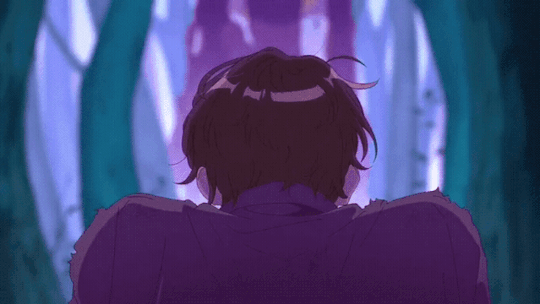
This particular scene in I Love You is extremely important: namely, it's the location of her victim's death.
If we look at Mahiru's incarnation records, her victim died in Aokigahara, Japan's infamous suicide forest. This makes sense given he had died by hanging.
At least since the 1960s, Aokigahara has become associated with suicide, eventually becoming known in English by the nickname "Suicide Forest" and gaining a reputation as one of the world's most-used suicide sites.


Adding onto this, we know Mahiru went with her boyfriend to Aokigahara. First, ofcourse, the two are seen walking through a literal forest. Second, in Mahiru's Undercover memories, the sleeves perfectly align with the clothes Mahiru and her boyfriend wear. There's no other day where these sleeves align—trust me, I checked.
Q. Can you drive a car? Mahiru: "I have a drivers license. But I'm only a 'paper driver.'"
A paper driver is someone who's license is only 'paper' because they don't use it. Aokigara is a two-hour drive away from Tokyo which is where Mahiru lives. If she doesn't drive then this might mean it was her boyfriend who drove them to Aokigahara.
So to recap, Mahiru and her boyfriend went to a suicide forest together. This does beg the question though: why did Mahiru come along? If she knew her boyfriend was suicidal then wouldn't she try consoling him? Unless, ofcourse, Mahiru also wanted to die.
02. Love Is Mine
When you peek into Mahiru's symbolism you'll notice one reoccurring theme: clinging onto someone until you both suffocate.

Beginning with this shot of Mahiru and her victim, she's depicted as the literal noose tied around her boyfriend's neck. However, as many have noted, it can also be interpreted as her comforting him. As opposed Haruka who's straddling ontop of his victim, Mahiru's boyfriend is laying on her lap while she gazes into his eyes. Although violent, it's a distinctly intimate scene.
Personally, I'm partial to the name theory which suggests each prisoner's name reflects something about their crime. I noted the meaning behind Mahiru's name here but I'll regurgitate it. Mahiru's name means "Midday" which fits along her description:
A prisoner who is like the sun, always chatting and laughing.
So, with the theory in mind, Mahiru's crime relates to her eternal sunny presence.
Along with this, each prisoner has the kanji for "wood" in their name and removing that kanji reflects an aspect of their crime. (For instance, Haruka (嬰) would be "baby" or "necklace" and Yuno (堅) would be "strong" or "resolute" like her real personality).

With out the wood kanji, Mahiru's name is 隹 which means means "bird," obviously relating to how Mahiru and her boyfriend are both bluebirds suffocating within their small birdcage. Their relationship was doomed from the beginning—as bluebirds are wild animals and therefore cannot survive in cages. It was inevitable one of them would've become stressed out and died. Put a pin in the birdcage symbolism since we'll came back to that.
Moving on, in her first voice drama, Mahiru reveals how her victim died:
Es: "I see. So, you became a murderer as a result of some relationship conflicts? Jealousy… Grudges… Having your partner stolen from you… Those stories aren’t all that uncommon now are they?" Mahiru: "You’re wrong. It wasn’t that. I…never even wanted to kill anyone in the first place!" Es: [pauses] Mahiru: "I just… I was… just being myself."
(honestly really frustrating how people still theorize mahiru/her boyfriend cheated when she expressed multiple times that wasn't the case. all of the victims apart from kotoko's were innocent people and mahiru "loving my bf is my defining personality trait" shiina isn't about to tap someone's elses ass. if anything this is a demonstration she was only stressed out about her partner leaving her but whatever i digress)
And then later on these exchanges happen:
Es: It was your love which killed someone, right? Despite that, will you still try to love another person? Mahiru: [thinks] Actually, I was hoping you could tell me the answer to that, prison guard… If what I did was unforgivable.
Mahiru: Ah, this isn’t good. Be careful, okay? Um… Um… If you’re that kind to me, you could die as well. Just—kidding?
So already, this theme of suffocation has been reinforced multiple times. Mahiru goes with her boyfriend to a suicide forest, she locks hands with him, she's symbolised as a noose hanging him, she's stuck in a birdcage with him, and it's her sunny disposition, her love for him which kills him.
Which forms the foundation for this theory: following her theme of clinging until suffocation, Mahiru tried to die alongside her boyfriend to forever stay with him.

Q. What is the ultimate form of Love?Mahiru: Being always together
Mahiru: My first shrine visit of the year was together with him. Obviously I know what I want to wish for. Please let us stay together like this forever. Please don’t let anyone else get in our way
Do you really think you know what love is? If you do, let's just overheat together! [Mahiru is outright singing, "Lets stay close together for so long we could die from the warmth.]
If you don't hug me, even our hearts will start drifting apart [Otherwise, "If you don't hold me close then I won't feel loved by you."
Mahiru: "Ehehe...I love, love, LOVE YOU!! Don't ever let me go, ok!"
The happiness we tightly bound up and suffocated, is no longer here
Which leads us to our third point: oh goodness Mahiru's relationship was a hot mess.
03. Love Is (Un)Dead
Okay, so we've established a lot but there's one thing missing: Is Mahiru herself suicidal?
Mahiru: It’s because I've… decided that I’m going to live for the sake of love
Mahiru: Hmm. If you can’t forgive me for what I’ve done, then there’s no point in living—to be honest. [laughs]
Mahiru: Being in love is… If there was no such thing as love, then my life would be so bland. So, if you say that I won’t be allowed it anymore, then there’s no point in me living.
An extremely unfortunate yes! Similar to how Shidou wishes to die because of his love, Mahiru only lives for the sake of love. (Infact, coasting off this shinju theory, I'd even say that both Shidou and Mahiru wanted to die for the sake of meeting their loved ones again.)
One specific detail I'd like to highlight are Mahiru's shoes.
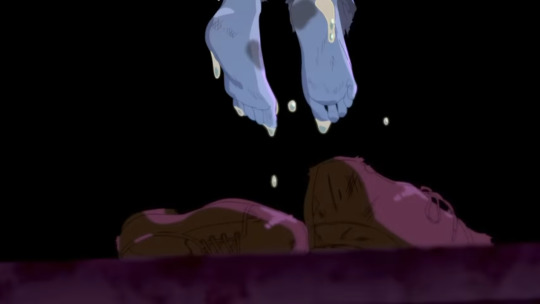
In Japan there is a custom for people to take off their shoes before entering their homes, as to not track dirt into their houses. As a result of this line of thinking there is also a custom where people take off their shoes before they enter the afterlife as not to track dirt and such into their ethereal destination. Abandoned pairs of shoes in Japanese media have become symbolic of suicides, and they are also common in non-Japanese media.
This specific symbolism is seen an additional time with Mahiru and Kazui's victims in Undercover and Mu in It's Not My Fault, both of which are related to suicide.


In Mahiru first MV, there's always a shot where we can explicitly see her shoes. They're on in the beginning, off when she confesses to her boyfriend and they begin dating, and on again after something happened to her boyfriend.
I believe this may represent she was suicidal during the relationship. Apart from this, there's lots of little details which paint the picture she was unhappy with her life and dating her boyfriend.
When being interviewed, she tends to talk a lot, and she seems to have developed some special feelings for the prison guard, and sometimes also shows a lonely, vacant expression in contrast to her normally bright and cheerful self. [These "special feelings" for Es aren't necessarily romantic. Atleast, it's "love" in the same way Mahiru thinks of a murder prison as a romantic getaway. It's moreso developes a connection with Es because they uniquely give her attention and she finds their hardwork admirable. She finds them kind and, "if youre kind to me I'm going to start relying on you, thanks!"]
"Hello! I’m Shiina Mahiru, 22 years old! I may be incompetent, but it’s a pleasure meeting you!"
Mahiru: Right…… so you too, Mu-chan…Hmm, I guess it’s because of the environment here. Sometimes your mental state has an impact. Mu: …You’re the same, then? …that it’s gone…… Mahiru: …it’ll be fine, it’ll be fine. This sort of thing happens all the time~
I guess we can just say that this feeling is happiness I can't stop feeling like there's something missing
We can both feel lonely sometimes, but wonder if you'll get angry soon
We fought sometimes, I was happy to get hurt Let's have matching pain, this sickness is pretty bad
This is a claim of responsibility From the two of us with matching love Wanting to know everything about you, but wanting to die because it can't come true It's all because of love
Don’t lose focus even when exercising! The pastel tones mean not only do you look ready to go but also give off a cute oneesan appeal. Even for a rougher style of dress you can’t be careless! Painted toenails and a necklace show some attention to detail to make for a sexy casual style. Just because it’s outdoors doesn’t mean you can relax too much! Even when picking out a date outfit to protect you from the cold, you still want to protect that loveable silhouette.
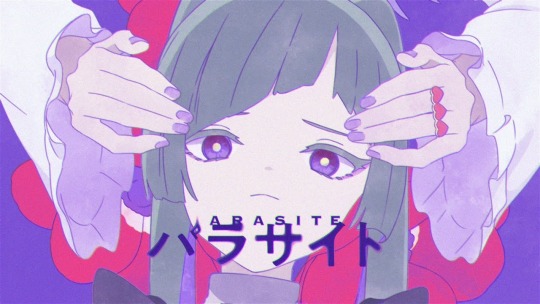
Most damning of all I'll say is Mahiru's parasite cover. The song tells a story about a scorned girlfriend who was used for sex and seeks alcohol in order to deal with her lingering feelings for ex-boyfriend. At one point Miku throws a bouquet back mirroring Mahiru's desire for a wedding.
(hmm funny how the "mahiru is a yandere because she covered psychogram" crowd was silent about this cover i wonder whyyyy)
Why can’t you understand? I hate you! Never touch me again
Wait a second, when did things start going wrong? I loved the bad parts too, everything was fine
It’s even worse when you are nice to me, But I don’t want to be given the cold shoulder [Most of all, Mahiru desires attention from her boyfriend. In her T1 MV she mentions how he "not the brightest so he never notices that I go to the beautician." This is a likely a blow to her self confidence given the heavy emphasis she has on appearing pretty. Sporadically across the magazines there's lines about "not slacking off" in public because people are always watching.]
Hey, give me back the time I used loving you, You liar. But I still love you
Hey, please don’t leave me behind, Hey, I’m hungry [This line always makes me so sad. In Mahiru's cover there's a beep to imply she's leaving this as a voice-mail for her boyfriend. Once again fulfilling our "stay with me always" clinging symbolism quota.]
Pretend not to see spitting out saliva, You're going to throw me away as incombustible waste
It’s just a bunch of “why”, I can’t change, I want to…I don’t want to leave
Hey, I want you to let me hug you at the last moment, thank you. And now, you are too (a parasite)
It's the last line I'd like to highlight because, all in one song, we've reinforced Mahiru's happiness in the relationship and the clinging symbolism. Mahiru and her boyfriend were both parasites who's clung onto eachother and deprived eachother of nutrients. Both of you suck!!
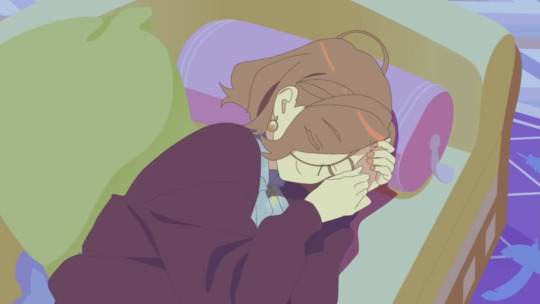


Then there's Mahiru's two symbolic locations: the birdcage and the carousel. Both of Mahiru's mindscapes places her in the same location: her home, as evident by the couches with pillows.
Personally, I subscribe to the idea the Day 16's house belong to Mahiru or it's a shared home with her boyfriend. If the poor financial situation theory is correct then the two might've decided to live together to cut costs (or Mahiru pressured him into agreeing). Her boyfriend works at a convenience store so he's probably not as financially well-off as Mahiru who recieves an allowance.
However, on a subconscious level, Mahiru thinks of her their home as a birdcage. As stated before, bluebirds can't survive in birdcages, and this is represented by her boyfriend's feathers falling from stress. Something interesting I'd like to note is that Mahiru considers leaving the birdcage but instead decides to dive back into the feathers, causing her boyfriend even more stress. Say with me: clinging 👏 until 👏 you 👏 suffocate 👏 imagery.
"Hmm... I’m a little troubled that I can’t go home, but... It’s fine, I guess. Even if I go home, there’s nothing left... And, I find it fun talking to you!"
Then, after her boyfriend's death, she thinks of their home as a carousel ride. The ledge at the beginning of the MV implies that—rather than an expansive space like Mu's beehive—the carousel is a small space. It's only Mahiru, the couch, the carousel, and a dead corspe. All she's able to do is fall asleep or ride the carousel again by herself, knowing she'll have to get off at some point. It's once again that imagery of something which is cramped and suffocating.
Both of her mindscapes cut them off from the outside world. Within her own mind all that matters is simply her and her boyfriend.
04. The Only You Can('t) Leave
Finally, I'd like to note something which has been sitting on my mind: Mahiru's themes of destiny and rebirth.
Q. What do you think happens when people die? Mahiru: They go to heaven!
Lovers committing double suicide believed that they would be united again in heaven, a view supported by feudal teaching in Edo period Japan, which taught that the bond between two lovers is continued into the next world, and by the teaching of Pure Land Buddhism wherein it is believed that through double suicide, one can approach rebirth in the Pure Land.

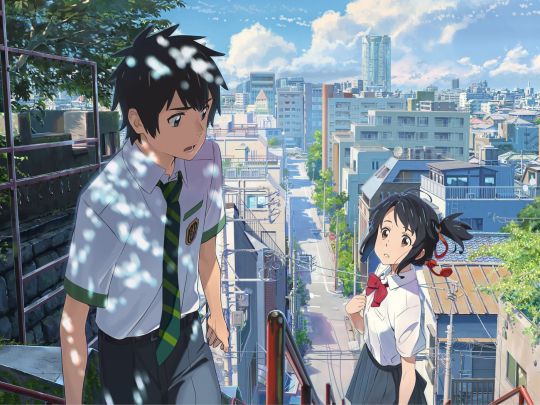
(big credit to doctorbunny's and archivalofsins's work on the this is how to be inlove with you locations for pointing this out! ily2 please check them out)
On Day 8, Mahiru goes with her boyfriend to go see "Your Name." Take this with a grain salt because I haven't see the actual movie— I refuse to watch a Makoto Shinkai film until he's allowed to write yuri—but the general gist is that two teenagers from 2013 and 2016 end up swapping bodies. Later, it's revealed that Mitsuha, the main heroine, is fated to die from a comet hitting the earth in the future. Fortunately, through time shenanigans, her fate ends up being altered and both teens end up surviving.
A romance movie featuring a dead lover and a mid relationship? Why, it's perfect for Mahiru!

The two people connected by the red thread are destined lovers, regardless of place, time, or circumstances. This magical cord may stretch or tangle, but never break. This myth is similar to the Western concept of soulmate or a destined partner.
Okay, okay, jokes aside that's not the sole reason I'm bringing up Your Name. Ofcourse, what's most interesting is it's theme of soulmates and how it relates to Mahiru.
Mahiru: Yeah. – Him and I… we loved each other. Properly as boyfriend and girlfriend. We met in college… It was the first time for me, so I don’t know if it was good or not, but… I think we were just normally going out together. I thought it was fate. He said it was, too.
Q. How did you meet your lover? Mahiru: We met eyes at the university terrace. I really felt like it was fate.
On the terrace at university, when I met eyes with that person I knew it must be fate. I might have been born purely so I could one day end up together with him. Or not, am I just overthinking things?
I ran into the person I’m interested in at the bread shop. This has to be fate, right? In the end I ended up buying the same bread as he got, but maybe I don’t need this much… > < I wasn’t thinking about the calories.
We went to one of the filming locations for a movie we both like! This sort of thing can only happen in Tokyo huh! It really must be fate that even our taste in movies lines up. I feel like a totally different person to before I met him… [Once again the movie she's talking about Your Name which is one of the highest grossing anime films of all times... bestie... ily but your rose colored glasses are blinding!!!]
Namely, once again, we're reinforcing the theme of clinging together until you suffocate. Two soulmates forced into loving eachother by the hands of fate. It's a very romantic idea twisted into something heart-wrenching.

The idea of "saving your lover from death" is briefly reflected Day 8 where Mahiru gives her boyfriend a hangover cure from called Corspe Reviver. A bit on the nose, don't you think?

This sections dawdles a little bit from the whole Shinju Theory but it felt off if I didn't include it. Given Shidou's entire character revolves around killing in order to save his loved ones, I can almost imagine Mahiru's murder was to save her boyfriend as well. There's not much evidence but... it's certainly there, right?
05. Conclusion
Aha, this post kind of devolved from "heres my shinju theory" and moreso "wow, Mahiru has a lot of suffocation imagery" which is true. There's so much of it. I don't even think this is all of it!
Theres alot more I wanted to add but... I'm not good with writing long posts if you couldn't tell! If anyone would like to add onto this for me I'd be thrilled ❤️
#take a shot every time the word suffocate or clinging crops up#like qjqjajajakak its actually insane to me how many times it pops up like????#I'm not even too confident in this theory because of how much i dawdle around but it's weird right!!!!#milgram#mahiru shiina#milgram theory#<- do not follow me for that tag btw i am not a theorist i just like mahiru alot#꒰ 🕊 ꒱ ── cinnamon lead astray
83 notes
·
View notes
Text
Improving some old HGS redesigns I did a few years ago
Since I'm back at that stage for some reasons I can say for certain I've definitely done a lot of redesigns of these characters, of course, not all of them were good, so I'm taking four of them that I never posted and pointing out where I messed up and trying to figure out what to do next . Rosemary - I feel like I made her hair too complex, It got so complex I made a chart with all the items in it. I need to trim the list down. I'm not completely sure I like the bangs I gave her. Prolly keeping the scars but I don't like the line weight I gave them. Also I NEED to bulk up her arms to show off her strength
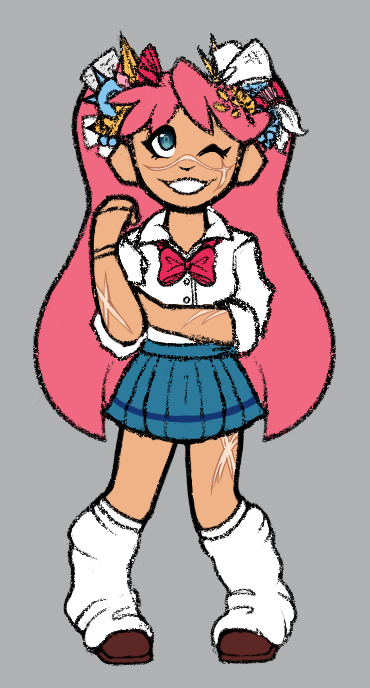
(There's 20 items here total, god almighty I'm gonna have a stroke, gonna have to trim the fat the moment I draw her again)

Sage - it's just I've updated the lore on witches so I need to add blue into her eyes. I'll make the braids chunkier so I don't have to draw tiny "Split Hearts". The rose and lavender need to be brighter since the lavender can barely be seen in her hat, might change some colors too. maybe desaturate the hat a bit too.

Parsley - Parsley definitely needs more of an overhaul. No orange on the boots. Give the belt done loops to slide through, gonna have to change up the belt color too. Also gonna add hair to her ears for sure. Might give her back her black brows because I forgot those. May re-redesign eyes too. Also. Not sure if the suspenders were a good idea. I wanted to connect it back to her causal outfit, but it looks like of awkward here. Maybe it just needs to be a different color? (And ACTUALLY attached to the belt?)
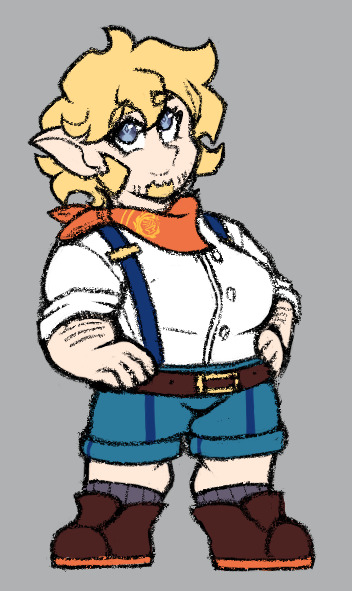
Thyme -Honestly the biggest flaw with Thyme is the shoes and that green. Also I'm not gonna use that logo for the shirt so it's outdated. I think I'll replace the green with gold Greek style sandles. These shoes aren't bad, they just don't fit. Maybe her old shoes can get recycled into something she wears from the fairy woods with her Giant Elf family and such. Also getting rid of the extra bandage on the leg.

That's all for today folks!
Not my best redesigns, but some elements I would definitely keep. Reminder that not every piece of art or first draft design is gonna be a banger and that's fine!
#art#fanart#high guardian spice#hgs#rosemary#sage#parsely#thyme#hgs rosemary#hgs sage#hgs parsely#hgs thyme#hgs redesign#self improvement#art improvement#personal improvement
21 notes
·
View notes
Text
‘Is blogging still relevant in the age of TikToks and Instagram?’
MDA 20009 Digital Communities
Hello and welcome to my blog, I hope you all had a great weekend :)
In today's “gen-z” era, media platforms like Tiktok and Instagram are becoming a frequent trend. As new forms of content such as videos, podcasts and social media platforms continue to dominate, some believe that the era of the traditional blog is coming to an end. One of the questions that is constantly being explored is, “In the age of TikToks and Instagram, is there still a point to blogging? However, based on my observations, I don't think blogging is dead, there is still a market for blogging, rather it has evolved and adapted to the changing digital landscape and can be differentiated from the audience of social media platforms. A closer look reveals that blogging will still have considerable value in 2024, for both individuals and businesses.
Before we dive into this topic, let's define Blog, Tiktok and Instagram.
Background: What is Blog, TikTok and Instagram?
According to Dennis, M.A. (2024), blog is an online journal in which an individual, group, or company presents a record of activities, thoughts, or beliefs. A blog consists of more than just words and pictures, and it can't be just words. Instead, it's a sum of text, layout, connections and links, and posting speed (Blogging, n.d.). Examples include blogger.com and wordpress.com, as well as Tumblr, which is the application you are now using to view this post :3
In addition, Herring et al.'s 2004 study showed that not only did personal blogs reveal their feelings and experiences, but that the mainstream media considered blogs to be newsworthy or relevant to current events, calling them “a new genre of journalism” (Filloux, 2009; Hermida, 2010), and that professional journalists were adopting the blog format as well.
Social media has been defined by Obar and Wildman (2015) that it is a mobile and internet-based platforms used to facilitate various forms of communication, social interaction, marketing and knowledge sharing (Hovestadt et al., 2021). Also, others define the term as ‘a web-based service or platform based on web 2.0 technology that enables sharing, co-creation, discussion and modification of user-generated content’ (Werder et al. 2014). Famous social media include Facebook, Twitter, Instagram and TikTok.
TikTok is a relatively new social media platform that allows users to create and share short videos of up to 15 seconds in length. As a user-generated content (UGC) platform, it has become a popular application for sharing videos (Feldkamp, 2021)
While research by Larson & Draper (2017), Instagram is a mobile application that allows users to instantly transform mobile phone snapshots into visually appealing images that can then be shared with others on the web Van Dijck (2013). TikTok and Instagram have become popular platforms for marketing campaigns because the content shared on these platforms is short, fun, trendy, creative and interactive (Zhang, 2020).
Do Blogging still holds significant value?
There is a perception that blogging may be seen as a dying industry.

Source: HubSpot
The data shows that 73% of respondents admit to skimming blog posts, while 27% read them carefully. Teicher (2020) has stated that 75% of the public prefers reading articles under 1,000 words. Teicher (2020) states that 75% of the public prefers to read articles of less than 1000 words.
Due to shifting consumption patterns and a culture of ‘instant gratification’ - in this age of instant information and short attention spans - a comprehensive and detailed approach to blog writing may seem somewhat outdated and unnecessary. Infographics and visualizations are designed to be visually appealing and interactive, which helps to capture the attention of the target audience more effectively than a lot of text (Blogging, n.d.).
However, in my opinion, blogging is not a dying industry. Even in the age of TikTok and Instagram, blogging is still relevant because of its unique capabilities, especially when it comes to deep content, personal expression, and fostering community engagement. Here are some statistics that prove that blogging is still significant.

Source: Statista

Source: Social Media Today
Evidently, there are 1.8 billion websites in the digital ecosystem and more than 600 million blogs worldwide (Armstrong 2021). Accordingly, 77% of internet users still read blogs. (Walker-Ford, 2017) which reveals that blogging is still incredibly valuable.

Source: HubSpot
On top of that, this survey results that show that blogging is still alive and well. The findings show that people enjoy reading blogs that teach them how to do new things, solve problems, and learn about new trends related to their career or industry.
Personally, I also like to use blogs when I'm learning something new, as it's perfect for providing in-depth tutorials, comprehensive guides or sharing personal experiences rather than short descriptions.
Additionally, blogs can be used not only for the purpose of sharing one's thoughts, but also as an educational tool. Oravec states that blogging is appropriate for students and helps to encourage participation in the classroom. According to Alsareef (2013), students are generally satisfied with taking courses online through social networks because it is easy to use, classes become more interesting, it provides more flexibility for extracurricular activities, and they are able to feel well educated.
Here's the end...
In short, blogging is still relevant in the age of TikTok and Instagram, and both platforms clearly have their own unique strengths and nuances. Blogging allows for in-depth content creation, while Instagram focuses on visual storytelling. However, blogs can continue to fulfill different social and informational needs, making them adaptable and relevant in the broader digital landscape. For example, blogs can also embrace the power of multimedia, and bloggers can consider incorporating images, infographics, and GIFs to enhance the visual appeal of their content and help segment text. According to a survey by Bump (2024), 32% of respondents said that videos, images, or other multimedia are the elements that interest them most when reading blog content.
Thank you for reading! See ya in next post ;)
Reference:
Alshareef, M. A. (2013). Evaluate student satisfaction for social learning network at King Abdulaziz University. Advances in Internet of Things, 03(03), 41–44. https://doi.org/10.4236/ait.2013.33006
Armstrong, M. (2021, August 6). How many websites are there? Statista Daily Data. https://www.statista.com/chart/19058/number-of-websites-online/
Blogging. (n.d.). Google Books. https://books.google.com.my/books?hl=en&lr=&id=VrhvqxjhSaEC&oi=fnd&pg=PP5&dq=blog&ots=JCUTMzaBSN&sig=aHWVbBua_dTSGpcZFQ4ctnfubOA&redir_esc=y#v=onepage&q=blog&f=false
Bump, P. (2024, January 2). The Top 3 Reasons consumers read blogs & How to attract them in 2024 [New data]. HubSpot. https://blog.hubspot.com/marketing/why-do-people-read-blogs#:~:text=In%20this%20blog%20post,%20I%E2%80%98ll%20walk%20you%20through#:~:text=In%20this%20blog%20post,%20I%E2%80%98ll%20walk%20you%20through
Dennis, M. Aaron (2024, September 17). blog. Encyclopedia Britannica. https://www.britannica.com/topic/blog
Feldkamp, J. (2021). The rise of TikTok: the evolution of a social media platform during COVID-19. In SpringerBriefs in information systems (pp. 73–85). https://doi.org/10.1007/978-3-030-66611-8_6
Hovestadt, C., Recker, J., Richter, J., & Werder, K. (2021). Digital responses to COvid-19. In SpringerBriefs in information systems. https://doi.org/10.1007/978-3-030-66611-8
Teicher, J. (2020, August 19). The lost art of the Mid-Range blog post. Contently. https://contently.com/2019/01/14/mid-range-blog-post/
Walker-Ford, M. (2017, December 4). The benefits of Blogging: 20+ stats Business owners need to know [Infographic]. Social Media Today. https://www.socialmediatoday.com/news/the-benefits-of-blogging-20-stats-business-owners-need-to-know-infograph/511816/
Van Dijck, J. (2013). Social media platforms as producers. ResearchGate. https://www.researchgate.net/publication/263565270_Social_Media_Platforms_as_Producers#:~:text=With%20the%20prolific%20use%20of%20social%20media%20platforms,
Zhang, J. (2020). Study on social media marketing campaign strategy -- TikTok and Instagram. https://dspace.mit.edu/handle/1721.1/127010
9 notes
·
View notes
Text
Some Gen Zers have grown critical of capitalism in recent years.
Rather than dismiss the whole system, many are embracing an idea one researcher calls "safety capitalism."
Gen Zers are less likely to take certain risks, which could be one reason they want more of a social safety net.
When someone loses their job or can't work for health reasons, how much government support should they receive? If you ask many Gen Zers that question, they'll say the current social safety net is insufficient.
Christina Elson, executive director of the Center for the Study of Capitalism at Wake Forest University, told Business Insider that many young people have embraced an idea she calls "safety capitalism."
The theory behind safety capitalism is that a successful capitalist system can and should provide sufficient protection — or safety — for those who need support following circumstances like a job loss or illness. One of the key questions facing any economic system is, "What should failure look like," Elson asked.
While many Americans receive support from a variety of social programs such as unemployment, food stamps, or disability, some of these have been scaled back since the height of the pandemic. As things stand, many Gen Zers think the US's social safety net is inadequate.
Sixty-five percent of Gen Zers think the government should provide a job to anyone who wants one, according to a Wake Forest survey of 2,000 Gen Zers and millennials conducted with YouGov in 2022. Forty-five percent said they had a positive impression of universal basic income policies. In a 2023 survey conducted by the same group, 65% percent of Gen Zers said unemployment payments should match one's salary.
Most Gen Zers still support capitalist ideas like private home ownership and entrepreneurship, Elson said. But many are frustrated with how the high costs of things like healthcare, housing, and education have taken a financial toll on Americans — and think these systems could benefit from more government intervention.
"You hear about 'billionaires should be outlawed' — that really isn't the issue," Elson previously told BI regarding Gen Zer's concerns. "The issue is the bottom. What is the appropriate bottom living standard for an American citizen, and what role should the government have in ensuring that people don't fall below that?"
Some are even turning away from capitalism altogether. In a Business Insider survey conducted last July of over 1,800 Americans, 28% of Gen Z respondents said they somewhat or strongly preferred the economic system of socialism over capitalism, the most of any generation. Twenty-nine percent of Gen Zers preferred capitalism — the rest didn't have a preference or weren't sure.
Why Gen Z wants an expanded safety net
Compared to past generations, young people today are less likely to drive, drink, have sex, and more likely to live at home, per some surveys. Elson said these examples point to a level of risk aversion that may be unique to Gen Zers.
"Gen Z are 'younger for longer,' — they go out into the world slower," she said, adding, "What is it that this generation needs in order to feel that they're able to go out there and take risks?"
Elson said many Gen Zers seek a "redesign of social safety" to enhance what some feel is an outdated system. For example, unemployment insurance and Social Security were introduced nearly 90 years ago during the Great Depression.
The financial challenges currently facing the Social Security system — due in part to the US's aging population — are arguably further evidence of a system that's in need of reform.
"All of this network has been designed for another time and place," Elson said.
Exactly what, if any, changes the US should make to its social safety net is up for debate. Some young people may look to Europe, where countries generally have a larger social safety net than the US.
In Germany, eligible unemployed individuals receive between 60% and 67% of their previous salary for up to a year. Policies like universal health insurance and guaranteed sick leave are also more common in Europe. Before temporary changes were enacted during the pandemic, most US states offered six months of unemployment benefits, with Americans collecting an average of $372 a week, per PBS.
Regardless, Elson said it's important that the US's entrepreneurial culture — which can reward risk-taking and drive economic progress — remains intact.
Most businesses fail, but as prominent investor Charlie Munger once said — and Elson referenced in a recent post — a level of failure may be necessary to have a thriving economy.
"Capitalism without failure is like religion without hell," Munger said.
19 notes
·
View notes
Text

gonna show off more concept art now that my project's finally launched to my english speaking crowd :3
this is isarno! she has gone through many design iterations. started off just with "hmmm i want a cat that can dig" and ended up here!


designs for the wolfdog mounts appearing in the first chapter. had a lot of fun designing the riding gear

and this is one of my first "proof of concept" drawings. the designs here are really outdated, but this is still one of my favorite pieces coming out of the comic so far



and even researched some old alpine folk art patterns to put on the character's woven cloaks

some OLDD concept art for you as well. there may or may not be sentient raven people in the story at some point
41 notes
·
View notes
Text
Destructive Criticism in the SSO Community
I have noticed the increasing amount of destructive criticism in the SSO community since the character update. It is clear the majority of the player base does not understand what constructive criticism is, and how it is harmful.
A quote from an article on thriveworks.com
“...constructive criticism uplifts, offers suggestions, and even provides possible solutions, destructive criticism is cutting, derogatory, and sometimes even mocks our failures.”
Everybody believes that Star Stable Online is a huge company, and that they should be held accountable for their poor management of the game. However, destructive criticism insults the recipient and offers no solutions for improvement. No matter how large a company may be, this type of criticism is unhelpful and overall unnecessary.
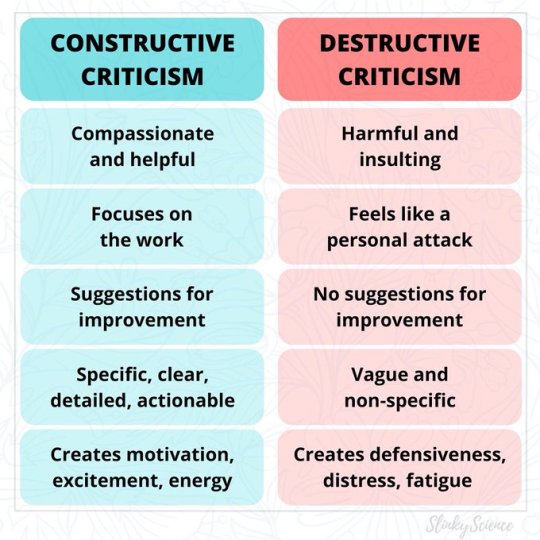
Image credit: Jayne Pritchard@SlinkyScience·Oct 13, 2020
More importantly in regards to the character update, by insulting the larger body types and particular facial features (ie. hooked noses, large lips) whether directly or indirectly is an outright attack on real people that have those characteristics. It has gotten to the point where people are being bullied over their CHARACTER’S APPEARANCE both in and outside of the game.
If you love this game so much but consistently attack the team at every opportunity, do you really love it at all?
I am an older player. I have been playing Star Stable since 2013. The character update is LONG overdue, and I am happy to see how much care and consideration they put into it. It is clear they wanted to be inclusive and provide a diverse range of options. It is a shame the player base had such a vile reaction. That is not denying the fact that there are issues.
Now, I am no video game designer BUT I do know a thing or two about website design and I know from experience that code never just works. At this point bugs are expected especially with such a large and important update.
Opinions are NOT constructive criticism. Personal opinions on the body types have no real value especially when y’all know good and well they said they would add more. Some players to simply call the characters “ugly” and not explain further because they don’t have a reason.
Artists that are familiar with the basic elements and principals of design understand the new characters are not poorly designed. The original character models were not badly designed either for that matter. They were simply outdated.
With that said let me address some of the complaints that have nothing to do with the design aspects of the characters:
Addressing Common Complaints:
The characters are too big? No. They aren’t. You are just accustomed to looking at a toothpick. The models have been scaled up to better suit the environment. You will get used to it.
The characters are too fat? Well it’s a good thing pixels weigh absolutely nothing.
There aren’t any skinny options. I want curves. COPE. There will be more body types released later, and if that really bothers you I think you should get a life and find something else to worry about.
I don’t like the giant facial features and hooked noses. They aren’t FOR YOU. Pick a face that doesn’t have them. There will be more added later.
Why couldn’t they just release it all the first time? It was stated in the news/blog they have to release it in small portions so not to overwhelm the toasters that some of y’all play on. Also this update has been highly anticipated and in this day and age of Tik Tok kids are too impatient to wait another year.
The animations are bad. They are far more realistic and natural than the original. See no.1
These complaints are all opinion based and have no valuable feedback. Constructive criticism looks at both the good and bad. Yes, you can like the new characters, but also not be entirely satisfied with them. In all fairness, they are unfinished (See complaints: no.5)
The overwhelming negativity in this community is going to drag us all to Hell. You simply cannot expect an MMO as old as Star Stable to not change. Look at School of Dragons for example. That game is being shut down because it could not keep up with the advancements or didn’t care to.
In conclusion: I am tired.
Thank you for coming to my TED talk.
57 notes
·
View notes
Note
You want some oc questions i'll give you some oc questions:
For those that dye their hair, do they have hair dying hangouts and if so, at whose house?
Do any of them have pets?
And do you have any other personality "identifiers" like zodiac or meyers briggs stuff for them? Oooh maybe like their animal crossing personality (if you've ever played that)
Thanks for your questions!!!
hmm I've never really considered this! Gia and Theo probably would, she has bright blue hair and at some point Theo gets pink hair. Also they're married so it makes the most sense hahaha... Dimitri and Oli might too, Dimitri's purple and Oli is blond but the back/underneath of his hair is black.
Oh and I'm just now remembering that Dimitri and Liv definitely do this together. I even drew them, this takes place at a way later part in the story.
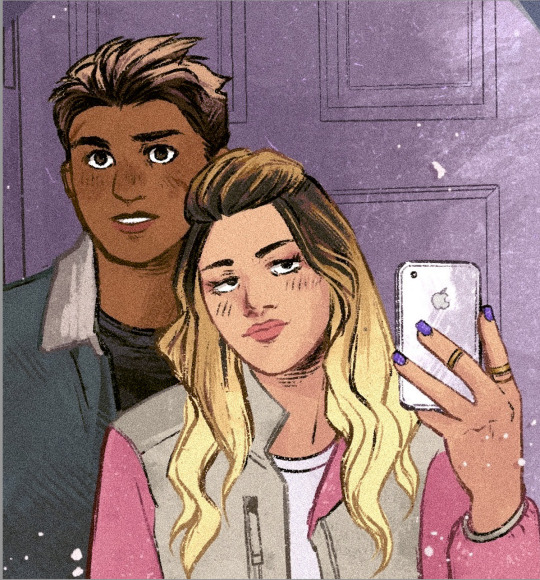
It would make a cute non-canon illustration to draw them all doing their hair together though!
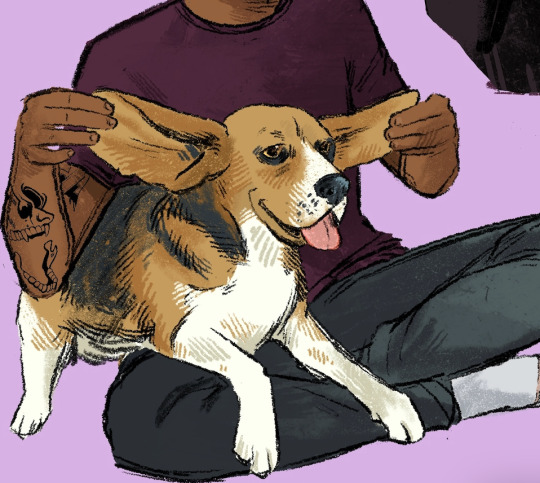
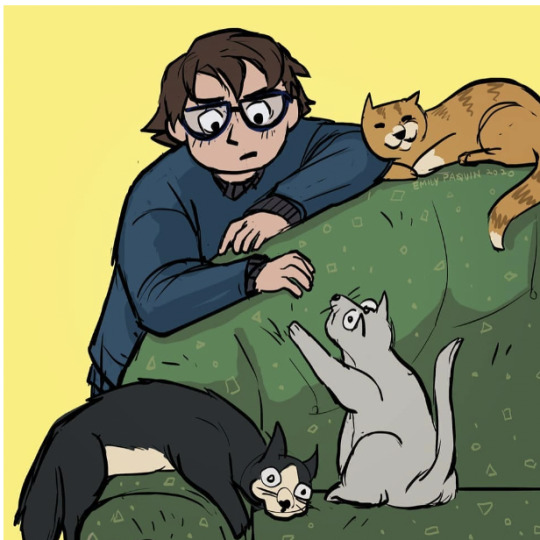
This is Dimitri's elderly beagle Fenway!! and also a TERRIBLE doodle of Lennon (very outdated design) with Alyssa's cats from January 2020. (I was a college animation major and trying to gear my art style closer to some cartoony stuff) One of Alyssa's cat's name is Plumbob. I thought for sure we had names for the other two but I can't find it in my notes at all! Eventually Lennon and Alyssa get two more cats together and Lennon names them Monopoly and Xerox. Alyssa's dream pet is a cow and she wants to name it Peanut Butter!!
Here is most of the character's birthdays and signs and some MBTI
Lennon McManus - June 21 1986. Cancer. ISFP.
Dimitri William Stanley Wretzky - October 3 1983. Libra. ENFP
Enzo Vincenzo - November 1 1986. Scorpio. ISTJ
Theodore (Theo) Stussy - February 20 1984. Pisces.
Olivier LaBlanc - April 2 1985. Aries.
Olivia (Liv) Godding - July 30 1985. Leo.
Rosalynn (Rosie) Langley - January 28 1986. Aquarius.
Parker (Park) Oakley - December 3 1989. Sagittarius.
Alyssa (needs a last name ahhhh) - May 19 1989. Taurus.
I'd give them animal crossing personality types but the categories are too narrow? If that makes sense.
23 notes
·
View notes